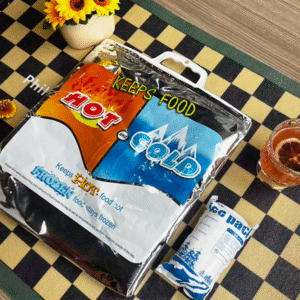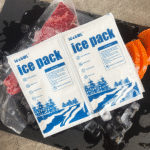How to Optimize Cold Chain Transport with Logistics Dry Ice Packs
In the fast-paced world of logistics, maintaining a reliable cold chain is crucial. Logistics dry ice packs are an essential tool in ensuring that temperature-sensitive goods arrive at their destination in perfect condition. Que vous expédiiez les produits pharmaceutiques, nourriture périssable, ou des produits chimiques, these packs offer the necessary cooling power for long-duration transport. This article will explore how to use dry ice packs effectively in cold chain logistics, ensuring cost savings and product integrity.

-
How do logistics dry ice packs maintain temperature control in cold chain transport?
-
What are the benefits of using logistics dry ice packs over traditional cooling methods?
-
How can businesses maximize the efficiency of logistics dry ice packs?
-
What are the latest trends in logistics and cold chain technology?
How do logistics dry ice packs maintain temperature control in cold chain transport?
Logistics dry ice packs play a vital role in maintaining a consistent temperature throughout the shipping process. Glace sèche, ou dioxyde de carbone solide, sublimates at -78.5°C (-109.3°F), making it ideal for cooling applications. When used in cold chain logistics, dry ice packs maintain the low temperatures needed to preserve perishable items such as vaccines, fruit de mer, et aliments surgelés.
These packs are designed to absorb heat from the surrounding environment, ensuring that temperature-sensitive goods stay below critical thresholds. By keeping items at the proper temperature, logistics dry ice packs reduce the risk of spoilage and product damage. They also help companies comply with industry regulations and safety standards, which are crucial in sectors like pharmaceuticals.
How do logistics dry ice packs compare to traditional cooling methods?
Compared to traditional cooling methods like gel packs or refrigerated containers, logistics dry ice packs offer several advantages. One of the primary benefits is that dry ice does not melt into water, reducing the risk of water damage to your goods. Comme la glace sèche sublime dans le dioxyde de carbone, it evaporates completely, ne laissant aucun résidu liquide.
Dry ice packs are also more efficient than wet ice because they have a lower temperature and sublimate more slowly. This slow rate of sublimation allows dry ice to provide longer-lasting cooling, making it a cost-effective solution for extended shipping times. En plus, dry ice is more compact and lightweight than wet ice, saving valuable space in shipping containers.
| Avantage | Glace traditionnelle | Feuilles de pack de glace sèche | Impact on Your Business |
|---|---|---|---|
| Cooling efficiency | Moins efficace | Maintains colder temps longer | Reduced spoilage, safer products |
| Risk of water damage | Haut | No water damage | Improved product safety |
| Space and weight efficiency | Bulkier, plus lourd | More compact and lighter | Cost savings and logistical ease |
How can businesses maximize the efficiency of logistics dry ice packs?
To optimize the use of logistics dry ice packs, it’s essential to understand how to handle and store them properly. Voici quelques meilleures pratiques:
-
Stockage approprié: Dry ice should be stored in a well-ventilated area to allow the sublimation process to occur safely. Never store dry ice in airtight containers as the carbon dioxide buildup could cause an explosion.
-
Superposition: When packing cold chain shipments, use a combination of dry ice packs and insulation. This ensures that the dry ice stays cold longer and that the products are shielded from external heat sources.
-
Placement stratégique: Position dry ice packs near the items that need the most cooling, but ensure they do not come into direct contact with sensitive goods, which could freeze or damage them.
Exemple:
A global food supplier used logistics dry ice packs to transport seafood across long distances. By layering dry ice with insulation and carefully positioning it around the products, they achieved a 40% reduction in spoilage rates, leading to significant cost savings.
Latest Trends in Logistics and Cold Chain Technology
Alors que nous entrons dans 2025, several innovations are shaping the future of logistics, particularly in the cold chain industry. These technologies are enhancing the efficiency and reliability of temperature-sensitive shipments.
Solutions d'emballage intelligents
New packaging technologies, such as smart packaging and IoT-enabled monitoring systems, are becoming more prevalent. These systems provide real-time temperature tracking, allowing companies to monitor the conditions of their shipments remotely. Smart labels and sensors alert businesses to any temperature fluctuations during transit, helping to prevent potential spoilage and reducing the need for manual checks.
Durabilité dans la logistique de la chaîne du froid
Sustainability is a growing concern in the logistics industry, and cold chain transport is no exception. Many companies are looking for ways to reduce their carbon footprint while still ensuring that goods remain cold during transport. Eco-friendly dry ice solutions are gaining traction, offering a balance between cooling performance and environmental impact.
Latest Developments Overview
-
Emballage à température contrôlée: More advanced insulated packaging solutions are improving the effectiveness of logistics dry ice packs.
-
Automated Cold Chain Systems: Automation is making it easier to monitor and adjust the temperature in real-time, improving accuracy and reducing human error.
-
Carbon Footprint Reduction: Companies are adopting more eco-conscious practices, such as using sustainable materials and minimizing waste in their cold chain operations.
Insistance au marché
The demand for cold chain logistics is growing rapidly, driven by the rise of e-commerce and the increasing need for pharmaceuticals, nourriture, et autres marchandises périssables. According to recent market reports, the global cold chain logistics market is expected to grow by 15% annuellement, with dry ice playing a significant role in ensuring temperature control during transit. As consumer demand for fresh and safe products rises, logistics dry ice packs will continue to be a critical component in the supply chain.
Questions fréquemment posées
Q1: How long do logistics dry ice packs last during transport?
Logistics dry ice packs typically last between 18 à 24 heures, Selon des facteurs comme la quantité de glace sèche utilisée, the insulation quality, and the external temperature conditions. It’s important to monitor temperatures throughout the journey.
Q2: Can I reuse logistics dry ice packs?
Dry ice packs are generally single-use, as they sublimate during transport. Cependant, some companies are exploring reusable dry ice solutions that maintain their efficiency for multiple uses, Réduire les déchets.
Résumé et recommandations
En conclusion, logistics dry ice packs are essential for ensuring the integrity of temperature-sensitive products during transit. By providing efficient and consistent cooling, these packs help businesses reduce spoilage, comply with safety standards, and improve customer satisfaction. To maximize their effectiveness, businesses should follow best practices for handling, stockage, and layering.
Étapes suivantes:
If you are looking to improve your cold chain logistics, consider integrating logistics dry ice packs into your shipping strategy. Monitor real-time temperature data and make use of eco-friendly dry ice solutions to stay ahead in the market.
À propos du tempk
Et tempk, we specialize in providing high-quality dry ice solutions designed to optimize cold chain logistics. Our logistics dry ice packs are reliable, rentable, and tailored to meet the needs of modern businesses. With a focus on efficiency and sustainability, we help businesses keep their products cold and safe during transport.
Appel à l'action: Contact Tempk today to learn more about how our dry ice solutions can enhance your cold chain logistics and reduce costs.























